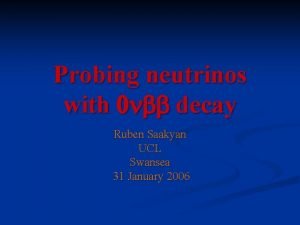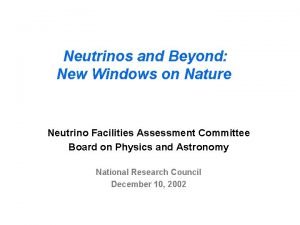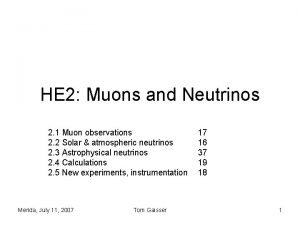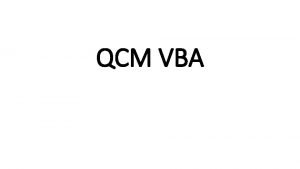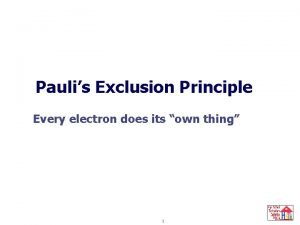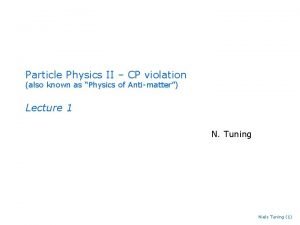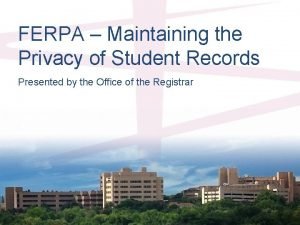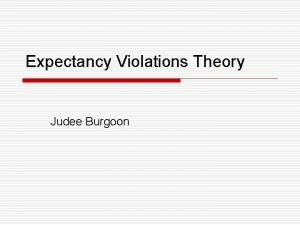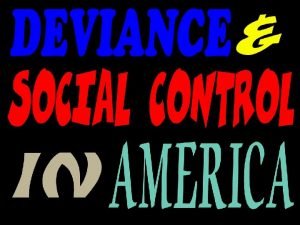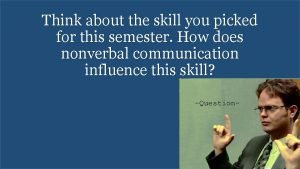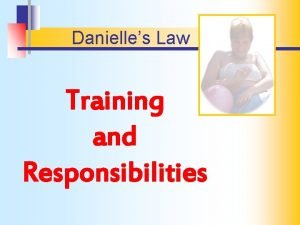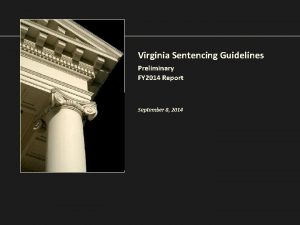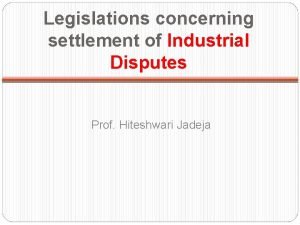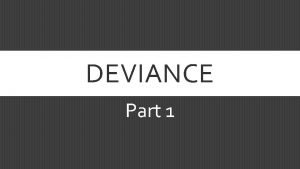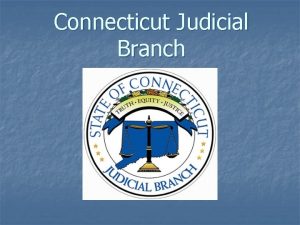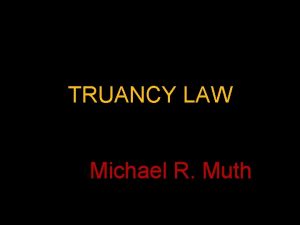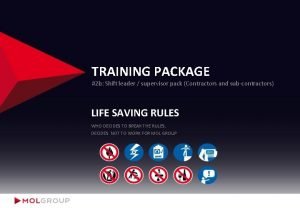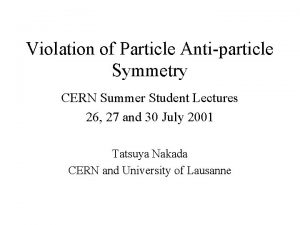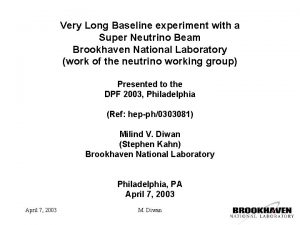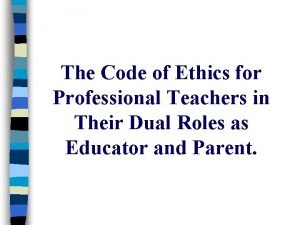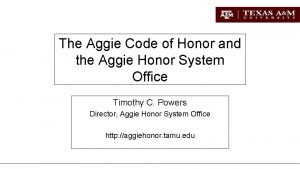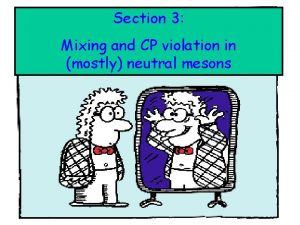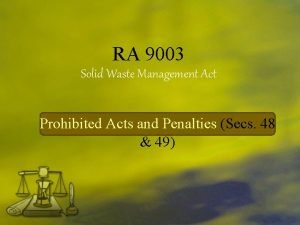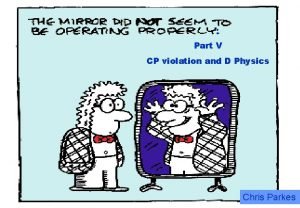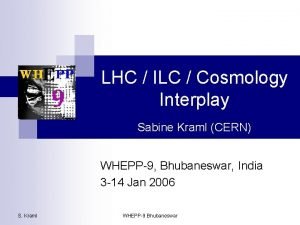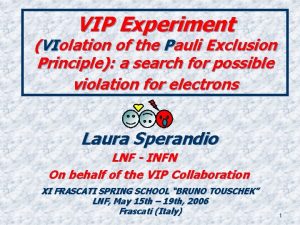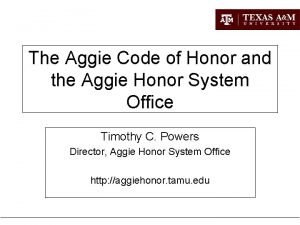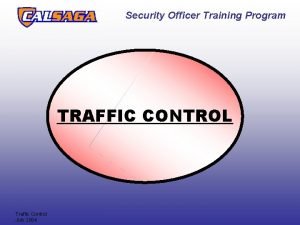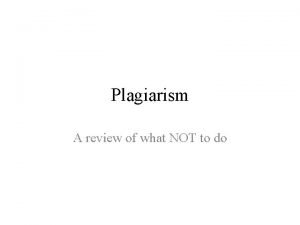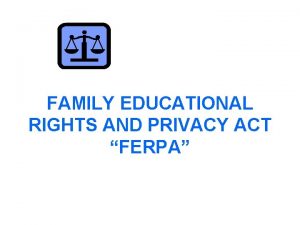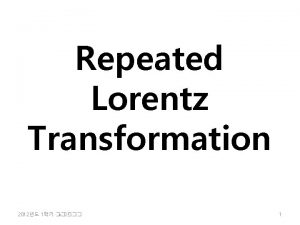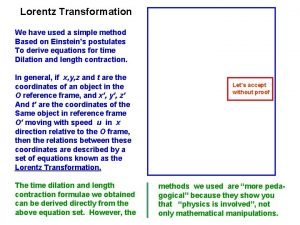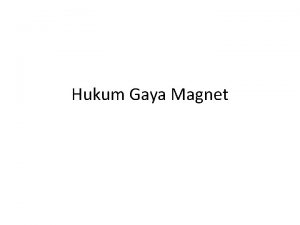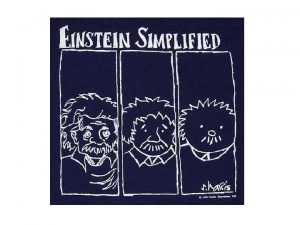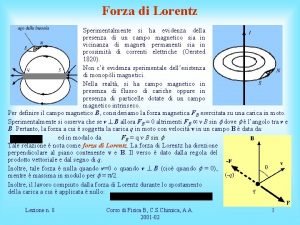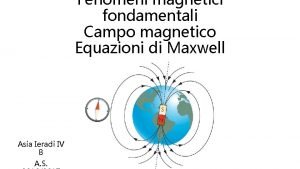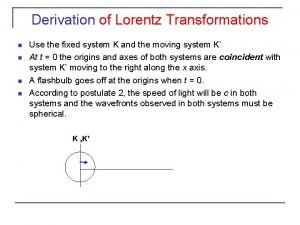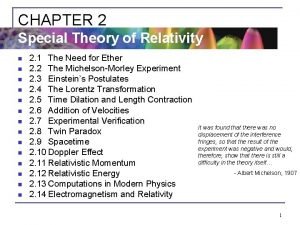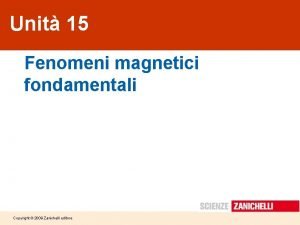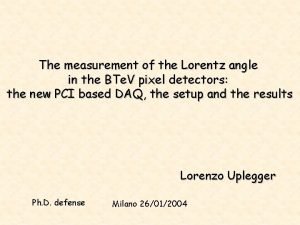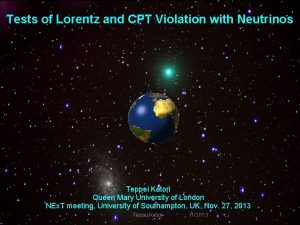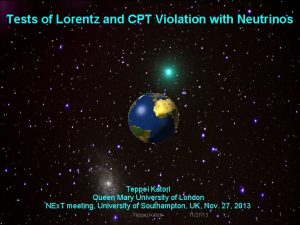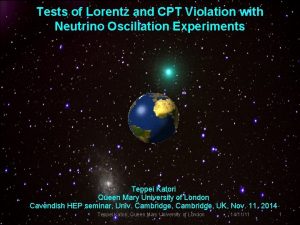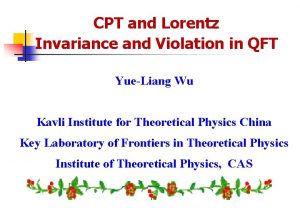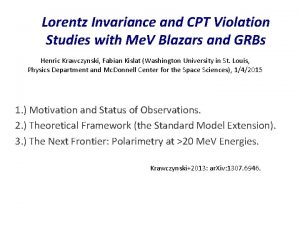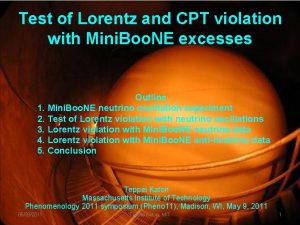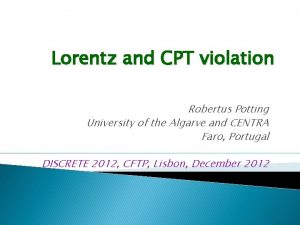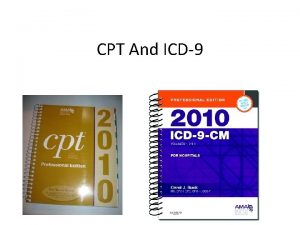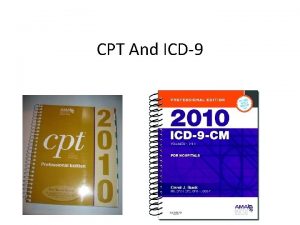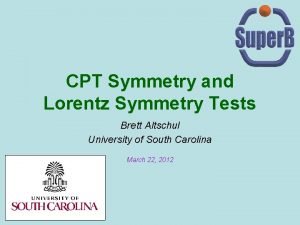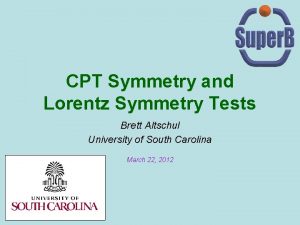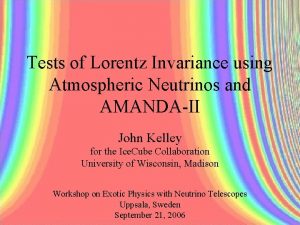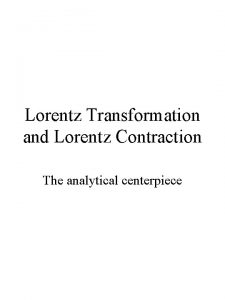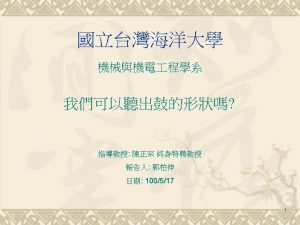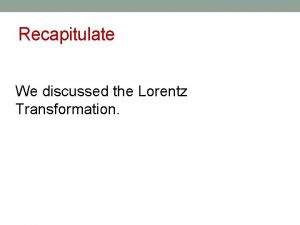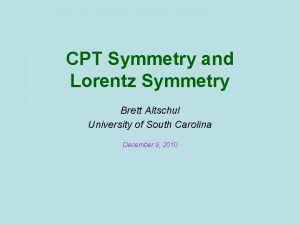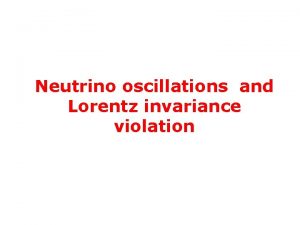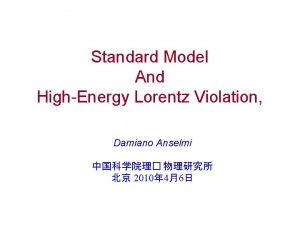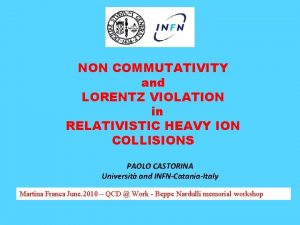Tests of Lorentz and CPT violation with Neutrinos















































- Slides: 47

Tests of Lorentz and CPT violation with Neutrinos Teppei Katori Massachusetts Institute of Technology ICHEP 2012, Melbourne, Australia, July 10, 2012 07/10/12 Teppei Katori, MIT 1

Tests of Lorentz and CPT violation with Neutrinos Teppei Katori Massachusetts Institute of Technology ICHEP 2012, Melbourne, Australia, July 10, 2012 07/10/12 Teppei Katori, MIT 2

Tests of Lorentz and CPT violation with Neutrinos Outline 1. Spontaneous Lorentz symmetry breaking 2. What is Lorentz and CPT violation? 3. Test for Lorentz violation with neutrinos 4. Conclusion Teppei Katori Massachusetts Institute of Technology ICHEP 2012, Melbourne, Australia, July 10, 2012 07/10/12 Teppei Katori, MIT 3

1. Spontaneous Lorentz symmetry breaking 2. What is Lorentz and CPT violation? 3. Test for Lorentz violation with Neutrinos 4. Conclusion 07/10/12 Teppei Katori, MIT 4

1. Spontaneous Lorentz symmetry breaking (SLSB) Every fundamental symmetry needs to be tested, including Lorentz symmetry. After the recognition of theoretical processes that create Lorentz violation, testing Lorentz invariance became very exciting. Lorentz and CPT violation has been shown to occur in Planck-scale theories, including: - string theory - noncommutative field theory - quantum loop gravity - extra dimensions - etc However, it is very difficult to build a self-consistent theory with Lorentz violation. . . 07/10/12 Teppei Katori, MIT 5

1. Spontaneous Lorentz symmetry breaking (SLSB) Every fundamental symmetry needs to be tested, including Lorentz symmetry. After the recognition of theoretical processes that create Lorentz violation, testing Lorentz invariance became very exciting. Lorentz and CPT violation has been shown to occur in Planck-scale theories, including: - string theory - noncommutative field theory - quantum loop gravity - extra dimensions - etc However, it is very difficult to build a self-consistent theory with Lorentz violation. . . Spontaneous Symmetry Breaking (SSB)! Y. Nambu (Nobel Prize winner 2008), picture taken from CPT 04 at Bloomington, IN 07/10/12 Teppei Katori, MIT 6

1. Spontaneous Lorentz symmetry breaking (SLSB) vacuum Lagrangian for fermion e. g. ) SSB of scalar field in Standard Model (SM) - If the scalar field has Mexican hat potential SSB f 07/10/12 Teppei Katori, MIT 7

1. Spontaneous Lorentz symmetry breaking (SLSB) vacuum Lagrangian for fermion e. g. ) SSB of scalar field in Standard Model (SM) - If the scalar field has Mexican hat potential SSB f f Particle acquires mass term! 07/10/12 Teppei Katori, MIT 8

Kostelecký and Samuel PRD 39(1989)683 1. Spontaneous Lorentz symmetry breaking (SLSB) vacuum Lagrangian for fermion e. g. ) SSB of scalar field in Standard Model (SM) - If the scalar field has Mexican hat potential SSB f f e. g. ) SLSB in string field theory - There are many Lorentz vector fields - If any of vector field has Mexican hat potential SLSB f am 07/10/12 Teppei Katori, MIT 9

Kostelecký and Samuel PRD 39(1989)683 1. Spontaneous Lorentz symmetry breaking (SLSB) vacuum Lagrangian for fermion e. g. ) SSB of scalar field in Standard Model (SM) - If the scalar field has Mexican hat potential SSB f f e. g. ) SLSB in string field theory - There are many Lorentz vector fields - If any of vector field has Mexican hat potential SLSB Lorentz symmetry is spontaneously broken! 07/10/12 Teppei Katori, MIT f am am 10

1. Test of Lorentz violation is to find the coupling of these background fields and ordinary fields (electrons, muons, neutrinos, etc); then the physical quantities may depend on the rotation of the earth (sidereal time dependence). background fields of the universe vacuum Lagrangian for fermion Scientific American (Sept. 2004) solar time: 24 h 00 m 00. 0 s sidereal time: 23 h 56 m 04. 1 s (Earth rotation period) PM 6: 00 07/10/12 Teppei Katori, MIT AM 6: 00 11

1. Spontaneous Lorentz symmetry breaking 2. What is Lorentz and CPT violation? 3. Test for Lorentz violation with neutrinos 4. Conclusion 07/10/12 Teppei Katori, MIT 12

2. What is Lorentz violation? y x 07/10/12 Teppei Katori, MIT 13

2. What is Lorentz violation? hypothetical background vector field moving particle Einstein (observer) y x 07/10/12 Teppei Katori, MIT 14

2. What is Lorentz violation? Under the particle Lorentz transformation: y x 07/10/12 Teppei Katori, MIT 15

2. What is Lorentz violation? Under the particle Lorentz transformation: Lorentz violation is observable when a particle is moving in the fixed coordinate space y Lorentz violation! x 07/10/12 Teppei Katori, MIT 16

2. What is Lorentz violation? Under the particle Lorentz transformation: Under the observer Lorentz transformation: Lorentz violation is observable when a particle is moving in the fixed coordinate space y y x 07/10/12 x Teppei Katori, MIT 17

2. What is Lorentz violation? Under the particle Lorentz transformation: Under the observer Lorentz transformation: Lorentz violation is observable when a particle is moving in the fixed coordinate space y y x 07/10/12 x Teppei Katori, MIT 18

2. What is Lorentz violation? Under the particle Lorentz transformation: Lorentz violation is observable when a particle is moving in the fixed coordinate space Under the observer Lorentz transformation: Lorentz violation cannot be generated by observers motion (coordinate transformation is unbroken) all observers agree for all observations y y x x 07/10/12 Teppei Katori, MIT 19

1. Spontaneous Lorentz symmetry breaking 2. What is Lorentz and CPT violation? 3. Test for Lorentz violation with neutrinos 4. Conclusion 07/10/12 Teppei Katori, MIT 20

3. Test of Lorentz violation with neutrino oscillation experiments Lorentz violation is realized as a coupling of particle fields and background fields, so the basic strategy to find Lorentz violation is: (1) choose the coordinate system (2) write down the Lagrangian, including Lorentz-violating terms under the formalism (3) write down the observables using this Lagrangian 07/10/12 Teppei Katori, MIT 21

3. Test of Lorentz violation with neutrino oscillation experiments Lorentz violation is realized as a coupling of particle fields and background fields, so the basic strategy to find Lorentz violation is: (1) choose the coordinate system (2) write down the Lagrangian, including Lorentz-violating terms under the formalism (3) write down the observables using this Lagrangian - Neutrino beamline is described in Sun-centred coordinates Z Winter solstice Earth Sun Summer solstice Mini. Boo. NE 541 m Y MI 12 X 07/10/12 Fermilab Google© map Vernal equinox Autumn equinox Mini. Boo. NE beamline Teppei Katori, MIT 22

Kostelecký and Mewes PRD 69(2004)016005 3. Test of Lorentz violation with neutrino oscillation experiments Lorentz violation is realized as a coupling of particle fields and background fields, so the basic strategy to find Lorentz violation is: (1) choose the coordinate system (2) write down the Lagrangian, including Lorentz-violating terms under the formalism (3) write down the observables using this Lagrangian Standard Model Extension (SME) is the standard formalism for the general search for Lorentz violation. SME is a minimum extension of QFT with Particle Lorentz violation SME Lagrangian in neutrino sector SME coefficients 07/10/12 Teppei Katori, MIT 23

Kostelecký and Mewes PRD 70(2004)076002 3. Test of Lorentz violation with neutrino oscillation experiments Lorentz violation is realized as a coupling of particle fields and background fields, so the basic strategy to find Lorentz violation is: (1) choose the coordinate system (2) write down the Lagrangian, including Lorentz-violating terms under the formalism (3) write down the observables using this Lagrangian Various physics are predicted under SME, but among them, the smoking gun of Lorentz violation is the sidereal time dependence of the observables sidereal frequency solar time: 24 h 00 m 00. 0 s sidereal time: 23 h 56 m 04. 1 s sidereal time Lorentz-violating neutrino oscillation probability for short-baseline experiments 07/10/12 Teppei Katori, MIT 24

Kostelecký and Mewes PRD 70(2004)076002 3. Test of Lorentz violation with neutrino oscillation experiments Lorentz violation is realized as a coupling of particle fields and background fields, so the basic strategy to find Lorentz violation is: (1) choose the coordinate system (2) write down the Lagrangian, including Lorentz-violating terms under the formalism (3) write down the observables using this Lagrangian Various physics are predicted under SME, but among them, the smoking gun of Lorentz violation is the sidereal time dependence of the observables sidereal frequency solar time: 24 h 00 m 00. 0 s sidereal time: 23 h 56 m 04. 1 s sidereal time Lorentz-violating neutrino oscillation probability for short-baseline experiments time independent amplitude sidereal time dependent amplitude Sidereal variation analysis for short baseline neutrino oscillation is 5 -parameter fitting problem 07/10/12 Teppei Katori, MIT 25

LSND collaboration, PRD 72(2005)076004 3. LSND experiment LSND is a short-baseline neutrino oscillation experiment at Los Alamos. LSND saw the 3. 8 s excess of electron antineutrinos from muon antineutrino beam; since this excess is not understood by neutrino Standard Model, it might be new physics L/E~30 m/30 Me. V~1 LSND detector 07/10/12 Teppei Katori, MIT 26

LSND collaboration, PRD 72(2005)076004 3. LSND experiment LSND is a short-baseline neutrino oscillation experiment at Los Alamos. LSND saw the 3. 8 s excess of electron antineutrinos from muon antineutrino beam; since this excess is not understood by neutrino Standard Model, it might be new physics Data is consistent with flat solution, but sidereal time solution is not excluded. LSND oscillation candidate sidereal time distribution data flat solution 3 -parameter fit 5 -parameter fit Small Lorentz violation could be the solution of LSND excess 07/10/12 Teppei Katori, MIT 27

TK, Kostelecký, Tayloe PRD 74(2006)105009 3. Tandem Model Small Lorentz violation could be the solution of LSND excess. But can such solution be allowed by other experiments? It is possible to construct a phenomenological neutrino oscillation model, based on Lorentz violation, using only 3 free parameters (tandem model). LSND oscillation candidate sidereal time distribution Tandem model can reproduce: - solar neutrino oscillation - atmospheric neutrino oscillation - reactor neutrino oscillation - LSND neutrino oscillation Tandem model also predicts small excess at the low energy region for Mini. Boo. NE Recent development of Lorentz violating neutrino oscillation models, see for example, Diaz and Kostelecký, PRD 85(2012)016013 07/10/12 Teppei Katori, MIT 28

Mini. Boo. NE collaboration, Ar. Xiv: 1109. 3480 3. Mini. Boo. NE experiment Mini. Boo. NE is a short-baseline neutrino oscillation experiment at Fermilab. Neutrino mode analysis: Mini. Boo. NE saw the 3. 0 s excess at low energy region Antineutrino mode analysis: Mini. Boo. NE saw the 1. 4 s excess at low and high energy region (however Mini. Boo. NE low energy excesses are much bigger than tandem model prediction) FNAL Booster Mini. Boo. NE detector Magnetic focusing horn ~520 m 07/10/12 primary beam secondary beam tertiary beam (8 Ge. V protons) (2 Ge. V pions) (700 Me. V neutrinos) Teppei Katori, MIT 29

Mini. Boo. NE collaboration, Ar. Xiv: 1109. 3480 3. Mini. Boo. NE experiment Mini. Boo. NE is a short-baseline neutrino oscillation experiment at Fermilab. Neutrino mode analysis: Mini. Boo. NE saw the 3. 0 s excess at low energy region Antineutrino mode analysis: Mini. Boo. NE saw the 1. 4 s excess at low and high energy region Electron neutrino candidate data prefer sidereal time independent solution (flat) Electron antineutrino candidate data prefer sidereal time dependent solution, but statistical significance is marginal Neutrino mode Antineutrino mode We find no evidence of Lorentz violation 07/10/12 Teppei Katori, MIT 30

Katori, Ar. Xiv: 1206. 6915 3. Mini. Boo. NE experiment Mini. Boo. NE is a short-baseline neutrino oscillation experiment at Fermilab. Neutrino mode analysis: Mini. Boo. NE saw the 3. 0 s excess at low energy region Antineutrino mode analysis: Mini. Boo. NE saw the 1. 4 s excess at low and high energy region. Since we find no evidence of Lorentz violation, we set limits on the SME coefficients. These limits exclude SME values to explain LSND data, therefore there is no simple Lorentz violation motivated scenario to accommodate LSND and Mini. Boo. NE results simultaneously 07/10/12 Teppei Katori, MIT 31

Double Chooz collaboration, paper in preparation 3. Double Chooz experiment So far, we have set limits on 1. ne «nm channel: LSND, Mini. Boo. NE, MINOS (<10 -20 Ge. V) 2. nm «nt channel: MINOS, Ice. Cube (<10 -23 Ge. V) The last untested channel is ne «nt It is possible to limit ne «nt channel from reactor ne disappearance experiment P(ne «ne) = 1 - P(ne «nm) - P(ne «nt) ~ 1 – P(ne «nt) Double Chooz observed the 3. 1 s disappearance signal of electron antineutrinos from the reactor Near 10 m 3 overbdn 45 m Far 10 m 3 overbdn 45 m 1050 m 400 m 07/10/12 Teppei Katori, MIT 32

3. Double Chooz experiment Double Chooz collaboration, paper in preparation So far, we have set limits on 1. ne «nm channel: LSND, Mini. Boo. NE, MINOS (<10 -20 Ge. V) 2. nm «nt channel: MINOS, Ice. Cube (<10 -23 Ge. V) The last untested channel is ne «nt It is possible to limit ne «nt channel from reactor ne disappearance experiment P(ne «ne) = 1 - P(ne «nm) - P(ne «nt) ~ 1 – P(ne «nt) Preliminary Double Chooz observed the 3. 1 s disappearance signal of electron antineutrinos from the reactor Preliminary result shows small disappearance signal prefers sidereal time independent solution (flat) Preliminary We will be able to set limits in the e-t sector for the first time; ne «nt (<10 -21 Ge. V) 07/10/12 Teppei Katori, MIT 33

Conclusion Lorentz and CPT violation has been shown to occur in Planck-scale physics. There is a world wide effort to test Lorentz violation with various state-of-the-art technologies. LSND and Mini. Boo. NE data suggest Lorentz violation is an interesting solution to neutrino oscillation. Mini. Boo. NE antineutrino mode data prefer sidereal time dependent solution, although statistical significance is not high. Limits from Mini. Boo. NE exclude simple Lorentz violation motivated scenario for LSND. Mini. Boo. NE, LSND, MINOS, Ice. Cube, and Double Chooz set stringent limits on Lorentz violation in neutrino sector in terrestrial level 07/10/12 Teppei Katori, MIT 34

Bluhm, Kostelecky, Lane, Russell PRL. 88(2002)090801 Animation for proposed atomic clock experiment in space 07/10/12 Thank you for your attention! Teppei Katori, MIT 35

Backup 07/10/12 Teppei Katori, MIT 36

Mini. Boo. NE collaboration, PRL 102(2009)101802, PRL 105(2010)181801 3. Mini. Boo. NE oscillation analysis results Neutrino mode low energy excess Mini. Boo. NE see the excess in low energy region. Mini. Boo. NE low E ne excess Antineutrino mode excess Mini. Boo. NE see the excess in combined region. Mini. Boo. NE anti-ne excess 475 Me. V low energy high energy These excesses are not predicted by neutrino Standard Model (n. SM). Oscillation candidate events may have sidereal time dependence. 07/10/12 Teppei Katori, MIT 37

2. What is CPT violation? CPT symmetry is the invariance under CPT transformation CPT is the perfect symmetry of the Standard Model, due to CPT theorem CPT-even CPT-odd QED Weak QCD 07/10/12 Teppei Katori, MIT 38

2. What is CPT violation? CPT symmetry is the invariance under CPT transformation CPT is the perfect symmetry of the Standard Model, due to CPT theorem CPT-even CPT-odd QED Weak QCD Lorentz violation CPT-odd Lorentz violating coefficients (odd number Lorentz indices, ex. , am , glmn ) CPT-even Lorentz violating coefficients (even number Lorentz indices, ex. , cmn , kabmn ) 07/10/12 Teppei Katori, MIT 39

2. Modern tests of Lorentz violation http: //www. physics. indiana. edu/~kostelec/faq. html 07/10/12 Teppei Katori, MIT The last meeting of Lorentz and CPT violation was in summer 2010. Next meeting will be in summer 2013 40

2. Modern tests of Lorentz violation http: //www. physics. indiana. edu/~kostelec/faq. html 07/10/12 Topics: * searches for CPT and Lorentz violations involving birefringence and dispersion from cosmological sources clock-comparison measurements CMB polarization collider experiments electromagnetic resonant cavities equivalence principle gauge and Higgs particles high-energy astrophysical observations laboratory and gravimetric tests of gravity matter interferometry neutrino oscillations and decays of K, B, D mesons particle-antiparticle comparisons post-newtonian gravity in the solar system and beyond second- and third-generation particles space-based missions spectroscopy of hydrogen and antihydrogen spin-polarized matter * theoretical studies of CPT and Lorentz violation involving physical effects at the level of the Standard Model, General Relativity, and beyond origins and mechanisms for violations classical and quantum issues in field theory, particle physics, gravity, and strings Teppei Katori, MIT 41

Atomic Interferometer (a, c)n, p, e <10 -6 Tevatron and LEP -5. 8 x 10 -12<ktr-4/3 ce 00<1. 2 x 10 -11 2. Modern tests of Lorentz violation Steven Chu GRB vacuum birefringence ke+, ko-<10 -37 http: //www. physics. indiana. edu/~kostelec/faq. html Topics: searches for CPT and Lorentz violations involving PRL 97(2006)140401 CERN* Antiproton Decelerator -8 birefringence and dispersion from cosmological sources PRL 106(2011)151102 (Mp-Mp)/Mp<10 clock-comparison measurements Double gas maser CMB polarization PRL 102(2009)170402 bn(rotation)<10 -33 Ge. V collider experiments bn(boost)<10 -27 Ge. V electromagnetic resonant cavities equivalence principle gauge and Higgs particles high-energy astrophysical observations Test of Lorentz invariance with neutrinos is very interesting, Spin torsion pendulum laboratory and gravimetric tests of gravity because neutrinos are the least known standard -30 Nature 419(2002)456 be<10 Ge. Vmodel particles! matter interferometry neutrino oscillations and decays of K, B, D mesons Cryogenic optical resonator PRL 105(2010)151604 Dc/c<10 -16 particle-antiparticle comparisons post-newtonian gravity in the solar system and beyond PRL 107(2010)171604 secondand third-generation particles LSND MINOS FD Ice. Cube Mini. Boo. NE space-based missions spectroscopy of hydrogen and antihydrogen PRL 97(2006)021603 spin-polarized matter * theoretical studies of CPT and Lorentz violation involving physical effects at the level of the Standard Model, General Relativity, and beyond origins and mechanisms for violations classical and quantum issues in field theory, particle physics, gravity, and strings PRD 72(2005)076004 PRL 101(2008)151601 PRL 105(2010)151601 PRD 82(2010)112003 ar. Xiv: 1109. 3480 PRL 99(2007)050401 07/10/12 Teppei Katori, MIT 42

2. Neutrino oscillations, natural interferometers Neutrino oscillation is an interference experiment (e. g. double slit experiment) light source slits n 2 interference pattern n 1 screen For double slit experiment, if path n 1 and path n 2 have different lengths, they have different phase rotations and it causes interference. In terms of neutrinos, if Hamiltonian eigenstates n 1 and n 2 are different, that can be the source of neutrino oscillations. 07/10/12 Teppei Katori, MIT 43

2. Lorentz violation with neutrino oscillation Neutrino oscillation is an interference experiment (e. g. double slit experiment) nm nm If 2 neutrino Hamiltonian eigenstates, n 1 and n 2, have different phase rotations, they cause quantum interference. 07/10/12 Teppei Katori, MIT 44

2. Lorentz violation with neutrino oscillation Neutrino oscillation is an interference experiment (e. g. double slit experiment) nm Um 1 n 1 Ue 1* n 2 nm n 2 n 1 If 2 neutrino Hamiltonian eigenstates, n 1 and n 2, have different phase rotations, they cause quantum interference. If n 1 and n 2 have different couplings with Lorentz-violating field, that can be the source of neutrino oscillations. 07/10/12 Teppei Katori, MIT 45

2. Lorentz violation with neutrino oscillation Neutrino oscillation is an interference experiment (e. g. double slit experiment) nm Um 1 n 2 nm * Um 1 e 1 nm ne nem If 2 neutrino Hamiltonian eigenstates, n 1 and n 2, have different phase rotations, they cause quantum interference. If n 1 and n 2 have different couplings with Lorentz-violating field, that can be the source of neutrino oscillations. Interference fringe (oscillation pattern) depends on the sidereal motion. The measured scale of neutrino eigenvalue difference is comparable the target scale of Lorentz violation (<10 -19 Ge. V). 07/10/12 Teppei Katori, MIT 46

Kostelecký and Mewes PRD 69(2004)016005 3. Test of Lorentz violation with neutrino oscillation experiments Lorentz violation is realized as a coupling of particle fields and background fields, so the basic strategy to find Lorentz violation is: (1) fix the coordinate system (2) write down the Lagrangian, including Lorentz-violating terms under the formalism (3) write down the observables using this Lagrangian Standard Model Extension (SME) is the standard formalism for the general search for Lorentz violation. SME is a minimum extension of QFT with Particle Lorentz violation Modified Dirac Equation (MDE) of neutrinos CPT odd SME coefficients CPT even 07/10/12 Teppei Katori, MIT 47
 Neutrinos
Neutrinos Neutrinos
Neutrinos Neutrinos
Neutrinos Qcm vba
Qcm vba Ace different tests iq tests but
Ace different tests iq tests but Pauli exclusion principle violation
Pauli exclusion principle violation Charge parity violation
Charge parity violation Ferpa violations
Ferpa violations Expectancy violation theory judee burgoon
Expectancy violation theory judee burgoon The recognized violation of cultural norms.
The recognized violation of cultural norms. Communicator reward valence
Communicator reward valence Danielles law
Danielles law Virginia probation violation sentencing guidelines
Virginia probation violation sentencing guidelines When employees resort to unauthorized strike in violation
When employees resort to unauthorized strike in violation It is defined as the recognized violation of cultural norms
It is defined as the recognized violation of cultural norms Connecticut judicial branch
Connecticut judicial branch Violation of compulsory attendance req parent, etc
Violation of compulsory attendance req parent, etc Lsr violation
Lsr violation Where was the sussex pledge signed
Where was the sussex pledge signed Altering a drivers license may result in
Altering a drivers license may result in Measure h
Measure h Cp-violation
Cp-violation Teachers ethics
Teachers ethics Honor violation probation tamu
Honor violation probation tamu Cp-violation
Cp-violation Ra 9003 violation
Ra 9003 violation Type of violation
Type of violation Spectrum ilc 1002
Spectrum ilc 1002 Apc violation sophos
Apc violation sophos Pauli exclusion principle violation
Pauli exclusion principle violation Aggie code of honor
Aggie code of honor Traffic control violation sap
Traffic control violation sap Example of mosaic plagiarism
Example of mosaic plagiarism Ferpa violation
Ferpa violation Family educational rights and privacy act
Family educational rights and privacy act Info 2950
Info 2950 Lorentz transformation matrix
Lorentz transformation matrix Psk lorentz
Psk lorentz Lorentz transformations
Lorentz transformations Gaya lorentz pada muatan bergerak
Gaya lorentz pada muatan bergerak Proof of lorentz transformation
Proof of lorentz transformation Arah gaya lorentz
Arah gaya lorentz Verso forza di lorentz
Verso forza di lorentz Campo magnetico calamita
Campo magnetico calamita Lorentz transformation equation derivation
Lorentz transformation equation derivation Momentum in relativity
Momentum in relativity Motore elettrico zanichelli
Motore elettrico zanichelli Lorentz angle
Lorentz angle
